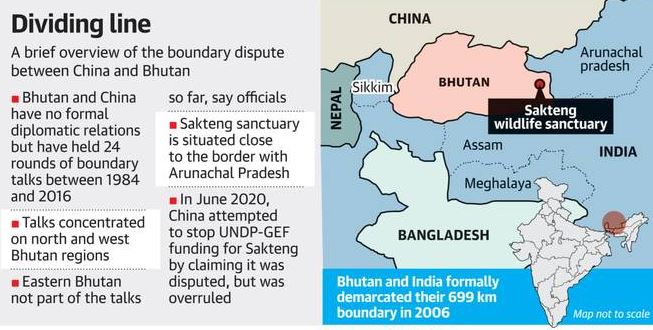Note4Students
From UPSC perspective, the following things are important :
Prelims level: Not much
Mains level: Bhutan-China Border Agreement

In a step towards resolving their boundary disputes, Bhutan and China signed an agreement on a three-Step roadmap to help speed up talks to “break the deadlock” in negotiations.
Bhutan-China Border Issues
Bhutan shares an over 400-km-long border with China.
- Doklam: China wants to exchange the valleys to the north of Bhutan with the pasture land to the west (including Doklam), totalling 269 square kilometres.
- Jakarlung and Pasamlung valleys: located near Tibet to Bhutan’s North, which measure 495 sq. kms.
- Sakteng Wildlife Sanctuary Project: China claims this area (near to Arunachal Pradesh) in eastern Bhutan as its own.
What is the recent agreement?
- The roadmap “for Expediting the Bhutan-China Boundary Negotiations”, is expected to progress on the boundary talks process that has been delayed for five years.
- It was stalled due to the Doklam standoff in 2017, and then by the Covid Pandemic.
- Although China and Bhutan do not have official diplomatic relations they have engaged in 24 rounds of ministerial-level talks to resolve their border dispute.
Implications for India
The boundary issue between China and Bhutan is special because it not only relates to Bhutan but also has become a negative factor for China-India ties.
- China control much of the Doklam: Since the 2017 stand-off with India, Beijing has already strengthened its de facto control over much of the Doklam plateau, located strategically along the India-China-Bhutan trijunction.
- Bhutan supports it: This agreement has been equally endorsed and appreciated by Bhutan and China.
- Deadlock at LAC talks: Its timing is particularly significant New, given India-China border talks on their 17-month-old standoff at the Line of Actual Control appear to have hit an deadlock.
- India’s strategic risks: This has big implications for India, since the Doklam swap would have given China access to the strategically sensitive “chicken neck” of the Siliguri corridor.
India’s interest
(a) Doklam
- The Doklam plateau remains hugely critical for India due to the Siliguri Corridor that lies to the south of Doklam.
- The corridor, also known as the ‘Chicken’s Neck’, is a 22-km wide major arterial road connecting mainland India with its northeastern states and thus it is a highly sensitive area for China.
(b) Sakteng: the hotspot
- The Sakteng sanctuary adjoins West Kameng district and Tawang disticts in India’s Arunachal Pradesh state.
- Its strategic value lies in its proximity to Arunachal Pradesh, where China claims around 90,000 sq km of Indian territory.
- Tawang, the major bone of contention between India and China in the eastern sector of their border dispute, lies to the northeast of the Sakteng.
Conclusion
- Bhutan has to balance its ties with India as well as China.
- We need to explore channels that India can activate with Bhutan when it comes to the highly sensitive matter of settling the boundary dispute between them and China.
UPSC 2022 countdown has begun! Get your personal guidance plan now! (Click here)
Get an IAS/IPS ranker as your 1: 1 personal mentor for UPSC 2024
